Our oceans are large, open spaces that are home to an incredible diversity of plant and animal species. It is also a home for potentially millions more that are so far – undiscovered. It is not every day we get to have the chance to encounter these creatures in real life so we have compiled a list of 10 unusual sea animals that you can encounter below 130 feet (40 meters). Let’s take a look!
Red-lipped batfish
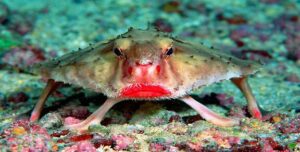
Scientific Name: Thymichthys politus
Description: The two really unusual things about the red-lipped batfish are its red lips and the weird shape of its body. Its fins and body have been modified to give it the appearance of a bat to some people, hence its name. Like many deep sea fish, red-lipped batfish are voracious carnivores. They use the modified dorsal spine as a lure (called an illicium) to attract prey. It is protected by an elongated snout. In general, they eat mainly small fish, mollusks, and crustaceans such as shrimps and crabs.
Location: Red-lipped batfish can be found at depths of 10 to 249 ft (3 to 75 meters), in the Pacific Ocean around the Galapagos Islands and off Peru.
Weedy Scorpionfish
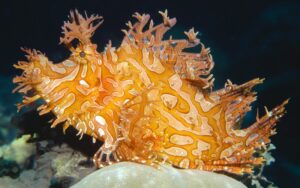
Description: The species varies in color from yellow to brown, green or black and is covered by a camouflaging maze-like pattern. Weedy scorpionfish are experts at disguising themselves, growing complex appendages to resemble the reef environment. If you can find them, they’re incredible critters to view while scuba diving.
Location: The weedy scorpionfish lives in the Indian Ocean and Western Pacific Ocean, from Japan to Australia and from South Africa to the Caroline Islands. They are found in depths ranging from 42 to 295 feet (13 to 90 meters).
Sea Angel
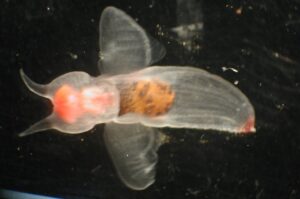
Scientific Name:Gymnosomata
Description: They are a large group of extremely small, swimming sea slugs, not to be confused with Cnidarians (Jellyfish and other similar creatures), classified into six different families. Sea angels are predators that devour other swimming snails, including sea butterflies.
Location: These organisms have a wide geographic range, from polar regions, under sea ice, to equatorial (tropic) seas. They typically live in the midwater zone, from the 65 feet to down to 2,000 feet deep (20 to 600 meters).
Blue Sea Dragon
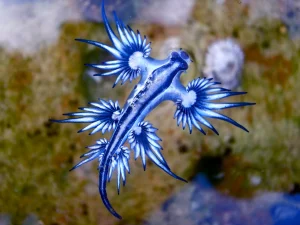
Scientific Name: Glaucus atlanticus
Description: These sea slugs are pelagic; they float upside down by using the surface tension of the water to stay up, where they are carried along by the winds and ocean currents. The silver/gray side of the sea slugs faces downwards, blending in with the sunlight reflecting on the ocean’s surface when viewed facing upwards underwater. Despite their small size, blue dragons pack quite a punch with their sting. The animal eats creatures like the venomous Portuguese man-of-war and stores its prey’s stinging cells, called cnidocytes, in sacs, Hicks said.
Location: This nudibranch is pelagic, and there is some evidence that it occurs throughout the world’s oceans, in temperate and tropical waters. They are found at around 3 ft down to 165 ft deep (1 to 50 meters).
Sarcastic Fringehead
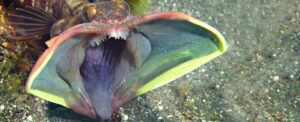
Scientific Name:Neoclinus blanchardi
Description: It is a small but very hardy saltwater fish that has a large mouth and aggressive territorial behavior, for which it has been given its common name. When two fringeheads have a territorial battle, they wrestle by pressing their distended mouths against each other, as if they were kissing. This allows them to determine which is the larger fish, which establishes dominance.
The name ‘fringehead’ refers to the floppy fronds of tissue that fall over the fish’s eyes, while the term ‘sarcastic’ is thought either to describe the animal’s sardonic closed-mouth expression, or to derive from the Greek word sarkázein, which means ‘to tear flesh’.
Location: They are found in the Pacific, off the coast of North America, from San Francisco, California, to central Baja California. Their depth range is from 10 to 240 ft (3 to 73 meters).
Variable Neon Slug
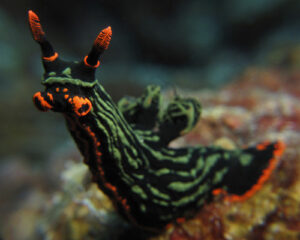
Scientific Name: Nembrotha kubaryana
Description: This animal can reach a total length of more than 5 inches (120 mm). It is a large dark-bodied nudibranch that may have green stripes running down the length of the body or have green raised spots. The margin of the foot and head is a vivid red-orange. Nudibranchs are a kind of sea slug, and their 3000 species are found from the poles to the tropics in both shallow and deep water.
Location: In Tanzania, they seem more common between 39 to 49 feet (12 to 15 meters) in depth range, but can be seen as deep as 300 feet (91 meters).
Psychedelic Frogfish

Scientific Name: Histiophryne psychedelica
Description:The psychedelic frogfish was first described in 2009 by Pietsch, Arnold, and Hall in the scientific journal Copeia, where they described it as having “a remarkable pigment pattern of white swirling stripes”, hence their use of the term psychedelic. The psychedelic frogfish has been known to reach a length of 5.9 inch (15 centimeters).
The fish’s diet likely consists of shrimp and small fish. Fish cannot be attracted using the illicium, as this spine is so reduced in size that it is unnoticeable externally.
Location: Found only in the waters around Ambon, Indonesia. They are described to be found at a depth of up to 300 feet (91 meters).
Pygmy Seahorse
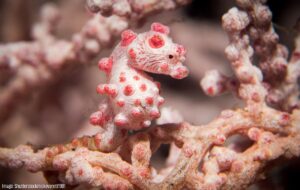
Scientific Name Hippocampus bargibanti
Description: The pygmy seahorse is both tiny and well-camouflagedcamouflaged. It is very difficult to spot among the sea grasses, soft corals, or gorgonians (sea fans) that it inhabits. Other distinctive pygmy seahorse characteristics include a fleshy head and body, a very short snout, and a long, prehensile tail. With their short snouts, they have the appearance of baby animals.
These underwater marvels are as rare as they are tiny. The world’s smallest seahorse, Satomi’s pygmy seahorse, measures just 0.55 inches (1.4 cm), which is smaller than a dime.
Location: Pygmy seahorses live between 52.5 to 131 feet (16-40 meters) deep. This species is known from coral reefs of the Western Pacific including Australia.
Banded Sea Krait
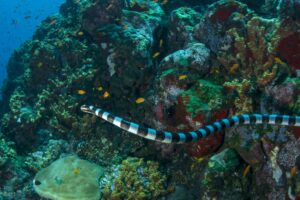
Scientific Name: Laticauda colubrina
Description: It is a species of venomous sea snake found in tropical Indo-Pacific oceanic waters. The snake has distinctive black stripes and a yellow snout, with a paddle-like tail for use in swimming. The neurotoxic venom of the banded sea krait makes it among one of the most lethal creatures in our oceans and its venom is 10 times more powerful than that of a rattlesnake. The venom attacks the nervous system of the victim and can result in convulsions, paralysis, cardiac failure, and even death.
Location: The yellow-lipped sea krait is widespread throughout the eastern Indian Ocean and Western Pacific. Sea kraits are capable of diving down to 260 feet (80 meters).
Ocean Sunfish
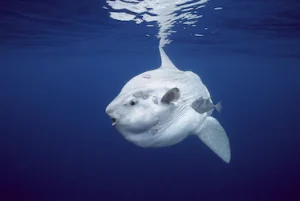
Scientists estimate that 91 percent of ocean species have yet to be classified, and that more than eighty percent of our ocean is unmapped and unexplored. Of all those we have included in our list, which do you think is the most creepy? Share with us in the comments section.

